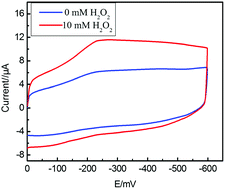A third-generation hydrogen peroxide biosensor based on horseradish peroxidase immobilized by sol–gel thin film on a multi-wall carbon nanotube modified electrode
Abstract
A third-generation H2O2 biosensor was developed by using tetraethoxy-silicone (TEOS) sol–gel film for the immobilization of horseradish peroxidase (HRP) on a multi-walled carbon nanotubes (MWNTs) modified glass carbon electrode (GCE). MWNTs have good promotion effects on direct electron transfer between the HRP and the electrode surface. The sol–gel film provided a favorable biocompatible microenvironment for the HRP. The performance and factors influencing the performance of the resulting biosensor were studied in detail. The developed biosensor was applied for fabrication of a sensitive and selective H2O2 biosensor with a low operation potential (−300 mV versus Ag/AgCl). The amperometric response was proportional to the H2O2 concentration in the range of 70 μmol L−1–3 mmol L−1 and the detection limit was 14 μmol L−1 at a signal-to-noise ratio of 3. The biosensor exhibited good sensor-to-sensor reproducibility (similar to 5%) and long-term stability (95% of its original activity retained after 60 days) when stored in 0.10 mol L−1 phosphate buffer solution at pH 7.0 and 4 °C.


 Please wait while we load your content...
Please wait while we load your content...